Article's Content
What’s the one mistake most content marketing teams make every year? Allowing existing content to collect dust while churning out more pieces.
This is what the content marketing process looks like for most SaaS companies:
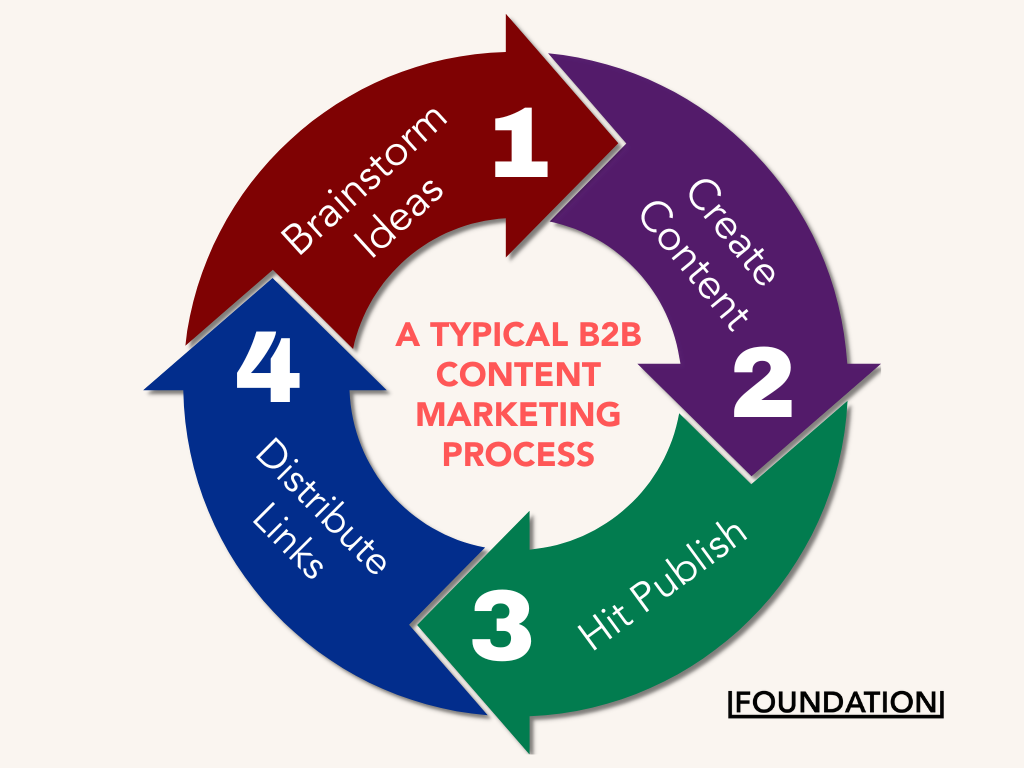
Every year, these brands pump more resources into brainstorming new ideas and developing them into content pieces. Then they hit publish, do a little victory dance, distribute links on social media a few times, and repeat the process for the next shiny idea.
While distributing links on social media seems like a good strategy, the drawback is that you miss out on tons of relationship- and revenue-generating opportunities.
Content distribution goes beyond publishing and hoping the right people stumble on your content and move down the pipeline. It also isn’t dumping links on social media without a strategy, or jumping onto social media trends that don’t align with that strategy.
A single piece of content repurposed the right way and repeatedly shared across different distribution channels can generate hundreds of thousands of dollars of ROI through revenue and relationships. That’s the power of content distribution.
Sadly, content distribution is still an underrated marketing tactic. Some marketers have misconceptions about content distribution that ruin their chances of generating massive ROI from their content marketing efforts.
We wrote this piece to identify and debunk six of these misconceptions so you can fully embrace and leverage content distribution. The tips in each section will help you boost organic reach, build stronger relationships with your audience, generate qualified leads, and increase conversions.
So let’s get to the good part.
A single piece of content repurposed the right way and repeatedly spread across different channels can generate $$$ of ROI through revenue and relationships. Share on X6 Content Distribution Misconceptions That Ruin Conversions
1. We Published a Great Piece of Content That Will Drive Traffic With Little or Zero Distribution.
There are four types of content marketers:
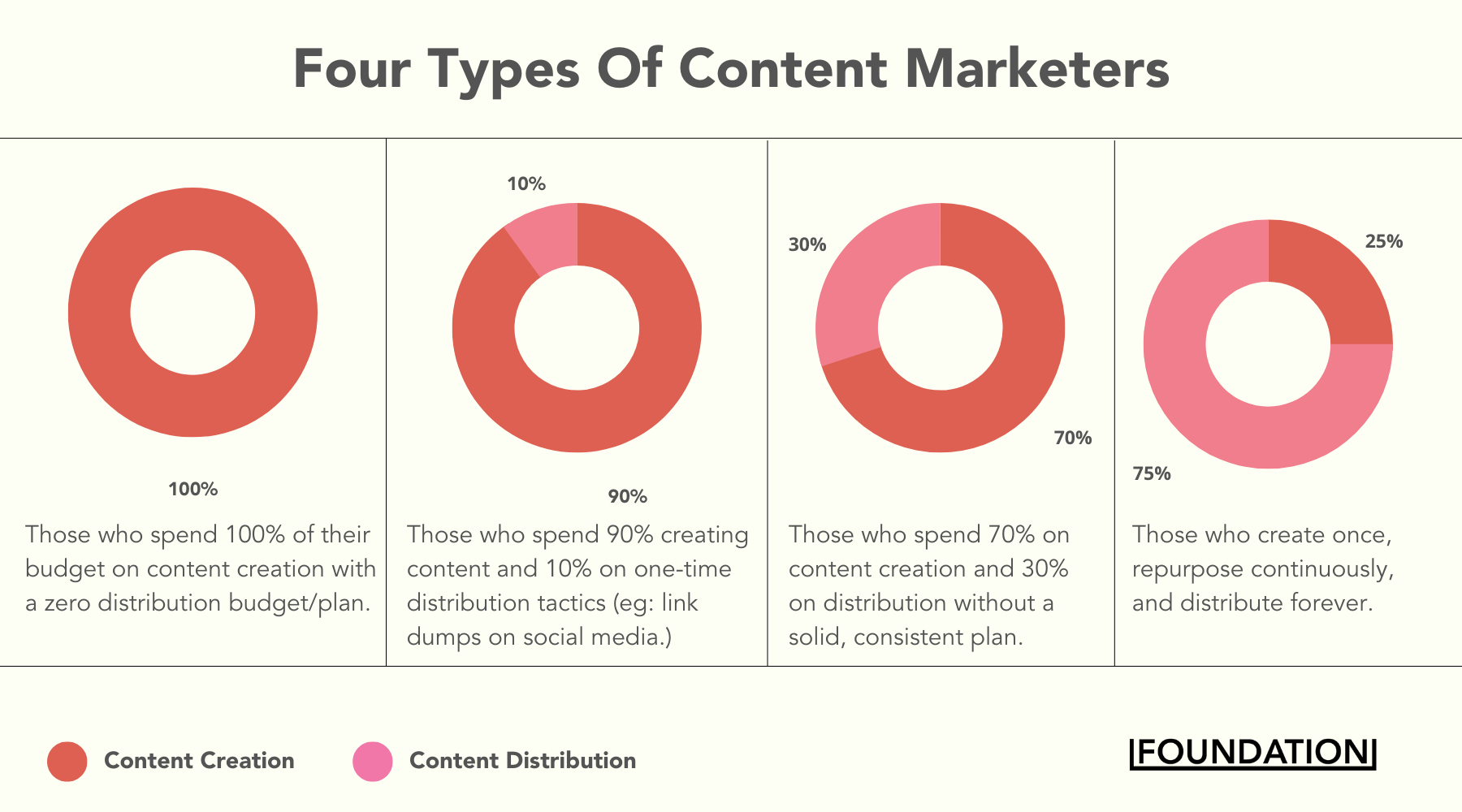
The first three categories of content marketers often depend on their published content to self-generate leads, but they forget content marketing is two-fold: the creating and marketing phases.
Hitting publish is the end of the creation phase and the beginning of the marketing or distribution phase. You shouldn’t publish content and hope your target audience stumbles on the piece. Instead, make a plan to get the right eyes on your content.
Great content dies prematurely when you don’t market your content. That’s why we should put the marketing back into content marketing. Ross Simmonds called this out while summarizing his MozCon session:
Smart marketing teams are embracing the idea that the lifecycle of their content doesn’t end when they hit publish, it’s just beginning. So, let’s put marketing back into content marketing. Our customers, audiences, and teams will be better off because of it.
So, how do you ensure you’re prioritizing distribution and getting your content in front of the right people?
You invest 75% of your resources into repurposing blog content into native content for your primary social channel(s) and consistently distribute the content.
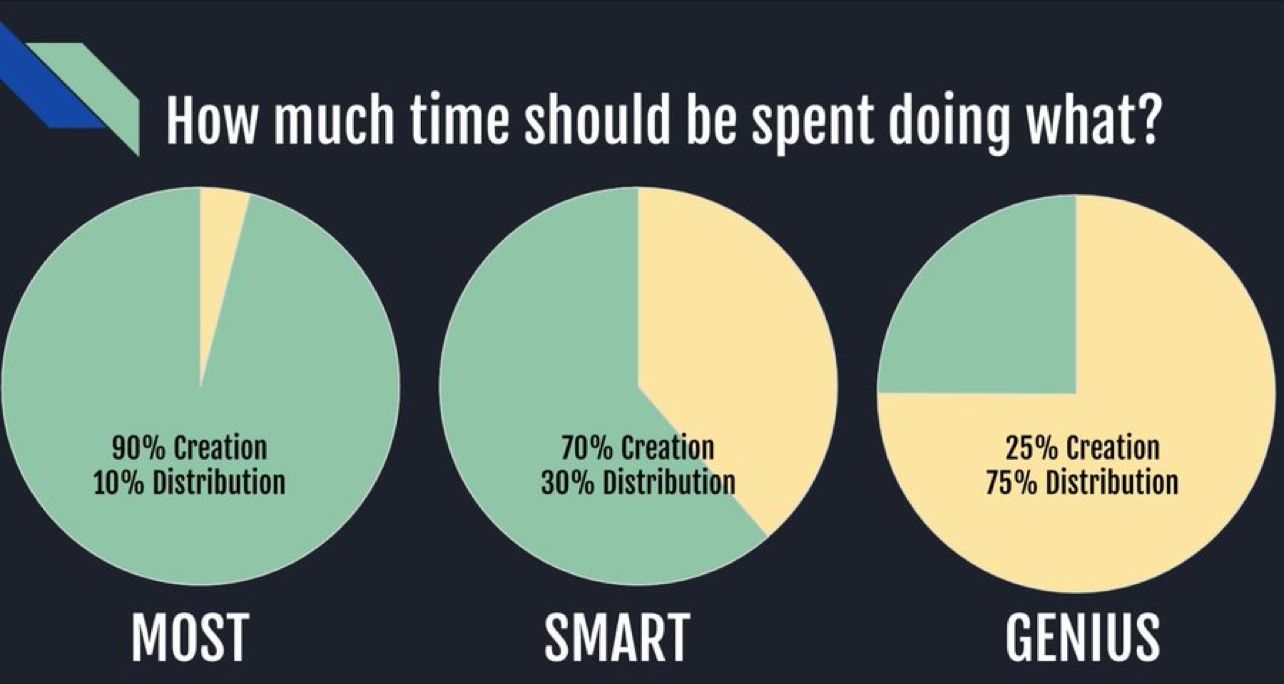
Be a genius marketer.
Content distribution takes work, and it is especially hard for smaller teams, but it is a highly rewarding task. It is the difference between a regular piece of content and one that generates hundreds of thousands of dollars in revenue.
Hitting publish is the end of the creation phase and the beginning of the marketing or distribution phase. Share on X
Our Canva case study is a great example of the unleashed revenue potential of a content piece. The study generated 26,282 page views in the first 7 days after hitting publish and hundreds of thousands of dollars in revenue since 2020.
The distribution strategy for this piece was pretty simple:
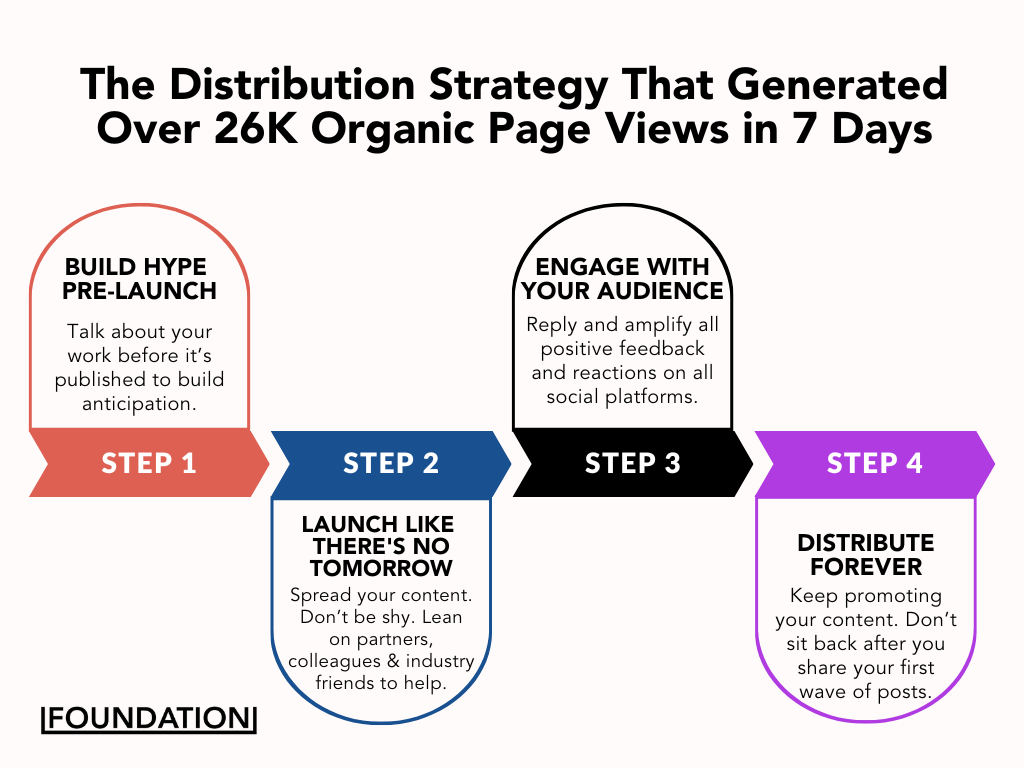
We built initial hype for the piece of content, set a launch date, spread the content on our social channels, leaned on partners, industry friends and colleagues, and engaged with every comment, repost, shares, and reactions. But we didn’t stop there.
We also created several native content pieces from the original piece and distributed them consistently on social media and online communities. The result was 26K+ page views, a steaming hot pipeline, and more revenue.
You, too, can unlock the full potential of the content you create by embracing distribution. You can get started with this strategy or join the distribution challenge—a 2-week training program breaking down the exact processes and strategies we use to drive growth for ourselves and our clients.
“Ross knows content marketing inside out, but if there’s one thing he’s the best in the world at… it’s content distribution. He just knows how to get the most out of one single piece of content than anyone else I’ve ever worked with.”
– Louis Grenier, Hotjar
2. We Don’t Have a Big Marketing Budget
This is another misconception that prevents marketing teams from reaping the full ROI of their content marketing efforts.
Here’s the thing: you don’t need a big marketing budget to reach millions, attract high-intent leads to your pipeline, or convert them to paying customers. What you do need, however, is a solid distribution plan.
We recently analyzed some of the work we did in 2021, and we found that blog posts that were actively distributed averaged 10x more page views than content that wasn’t.
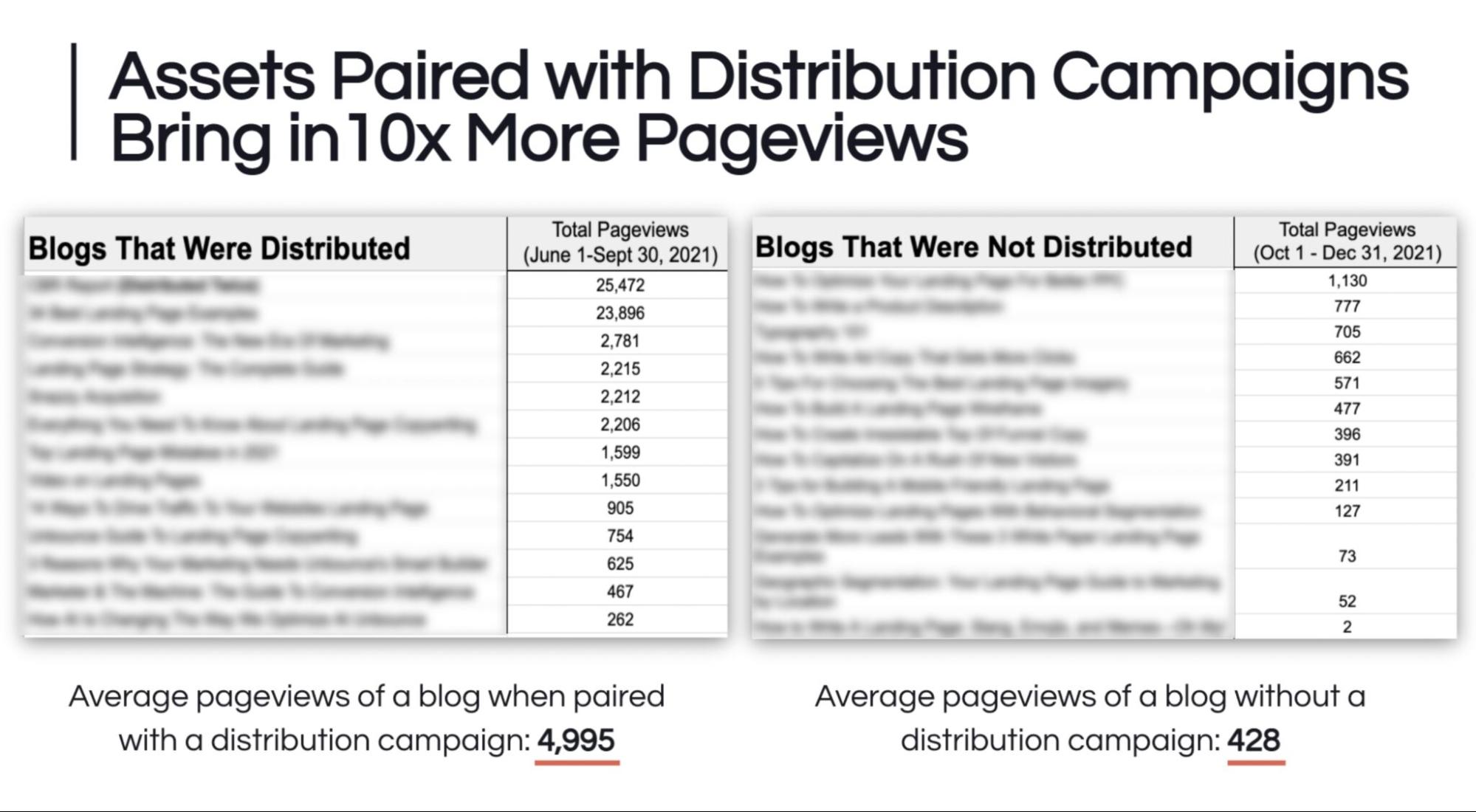
The pieces that performed better weren’t paired with paid distribution. It was organic distribution all the way. The results prove that your distribution plan is all you need to hit your marketing goals. You need great content pieces that directly address your target audience’s needs and a strategic distribution plan.
You don’t need a big marketing budget to attract high-intent leads to your pipeline or convert them to paying customers. You only need a solid distribution plan. Share on X
Dreamdata’s distribution strategy also proves that a big budget isn’t a drawback for market dominance. All you need is a collaborative team with a growth mindset and can-do attitude.
Six Dreamdata employees generated over 520K views and lots of reactions on LinkedIn in 91 days.

The team leveraged social selling (also called employee advocacy) on LinkedIn to generate brand awareness and revenue. Social selling means using your network or employees’ network to target prospects, build trust, and boost conversions.
Dreamdata’s playbook was simple.
First, the team set a goal to reach 300K views from all six team members’ efforts, and a reward—a team dinner at the end of the quarter if they hit the target. Then they got to work, posting consistently on a schedule and keeping each other accountable.
The result?

You guessed right: a team dinner! But there’s more.
The distribution strategy positioned Dreamdata as an authority for B2B Attribution. According to Dreamdata, the successful LinkedIn posts resulted in the activation of accounts that they had been attempting to reach outbound for months without success, as well as the generation of new revenue opportunities. Talk about the power of distribution!
This strategy worked wonders for the brand because Dreamdata created native content for LinkedIn. They also leveraged content best practices, including sharing educational and engaging content, incorporating social proof, showing their product in action, and engaging with comments and reactions.
Without a big budget, you can steal some pages out of Dreamdata’s playbook by:
- Targeting ideal customers with your LinkedIn content
- Building your LinkedIn social selling engine, one piece at a time
- Setting a consistent LinkedIn posting schedule
- Collaborating with team members to drive the social selling engine
That’s how you break through the budget bias. You can read the full Dreamdata case study here.
3. We’ll Share the Same Distribution Copy Across All Channels
Many B2B content marketing teams fall into the trap of sharing the same graphic and copy across all distribution channels.
The problem with this concept is that what works for X (formerly known as Twitter) doesn’t always work for LinkedIn. Same with Instagram, Facebook, Reddit, and other distribution channels. That’s why finding the right content-market-channel fit is important.
Content-market-channel fit simply means repurposing existing content into a format that suits a specific channel and distributing it on that channel.
Instead of replicating the same content format across platforms, you should repurpose your content into different formats to fit each channel.
For example, links to video content drive the most engagement for Reddit. 91% of active Instagram users also engage more with videos than other content types. LinkedIn users engage more with educational content. It’s no wonder LinkedIn makes up 50% of all social traffic from B2B websites. That’s why you should do more than dump links on LinkedIn or other social platforms.
Instead of replicating the same content format across platforms, repurpose your content into different native formats to fit each distribution channel. Share on X
Luckily, Melissa Zehner, Director of Content at Foundation, says it’s easier than many people think to repurpose and remix content for individual channels.
“No, you shouldn’t share the same exact copy or graphics across each distribution channel—but you don’t have to reinvent the wheel with each asset either. Often, a few small tweaks to your messaging, value propositions, or visual aids is all it takes to make an asset feel relevant to the channel it’s being shared on. Just shared a longer post on LinkedIn? Take the most impactful statement from that long-form post and leverage it as a [post]. And so on…”
Hootsuite is an example of a brand that repurposes existing content to fit different channels. Here’s what Hootsuite’s repurposing menu for this piece looks like:
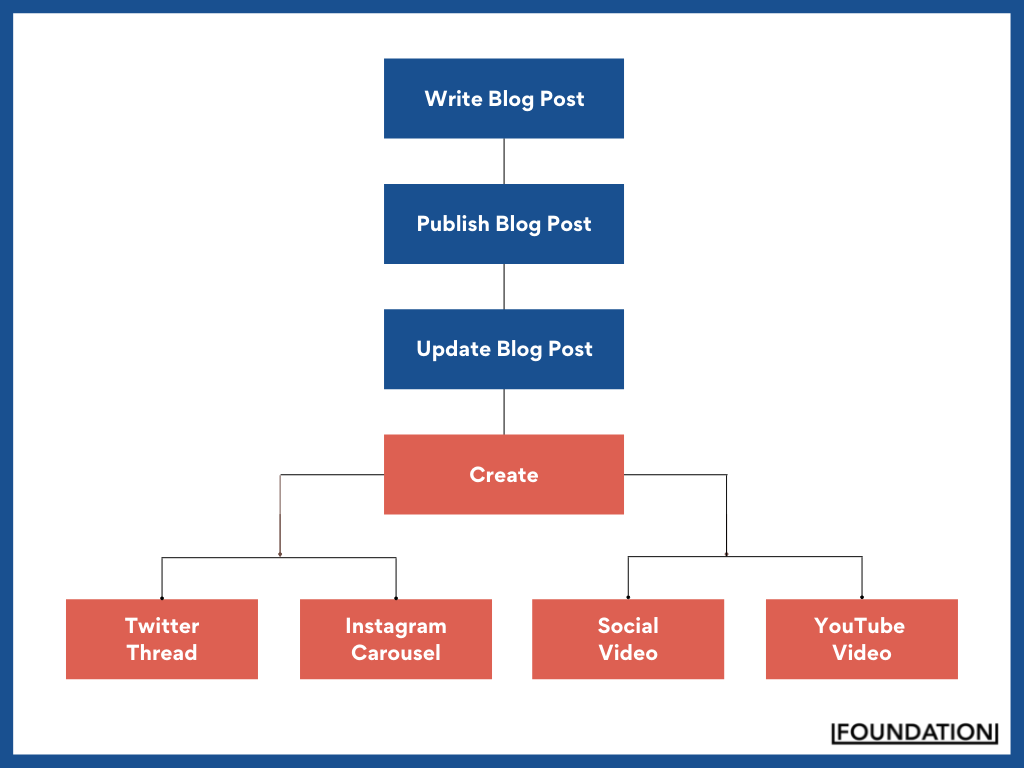
Instead of creating the same content for each channel, they create native content for each platform to reach their audience.
For example, Hootsuite released a digital report for 2022. They turned different stats into social graphics suited for different platforms to get more eyes on the content. Like this one on Instagram that has generated over 12K views:
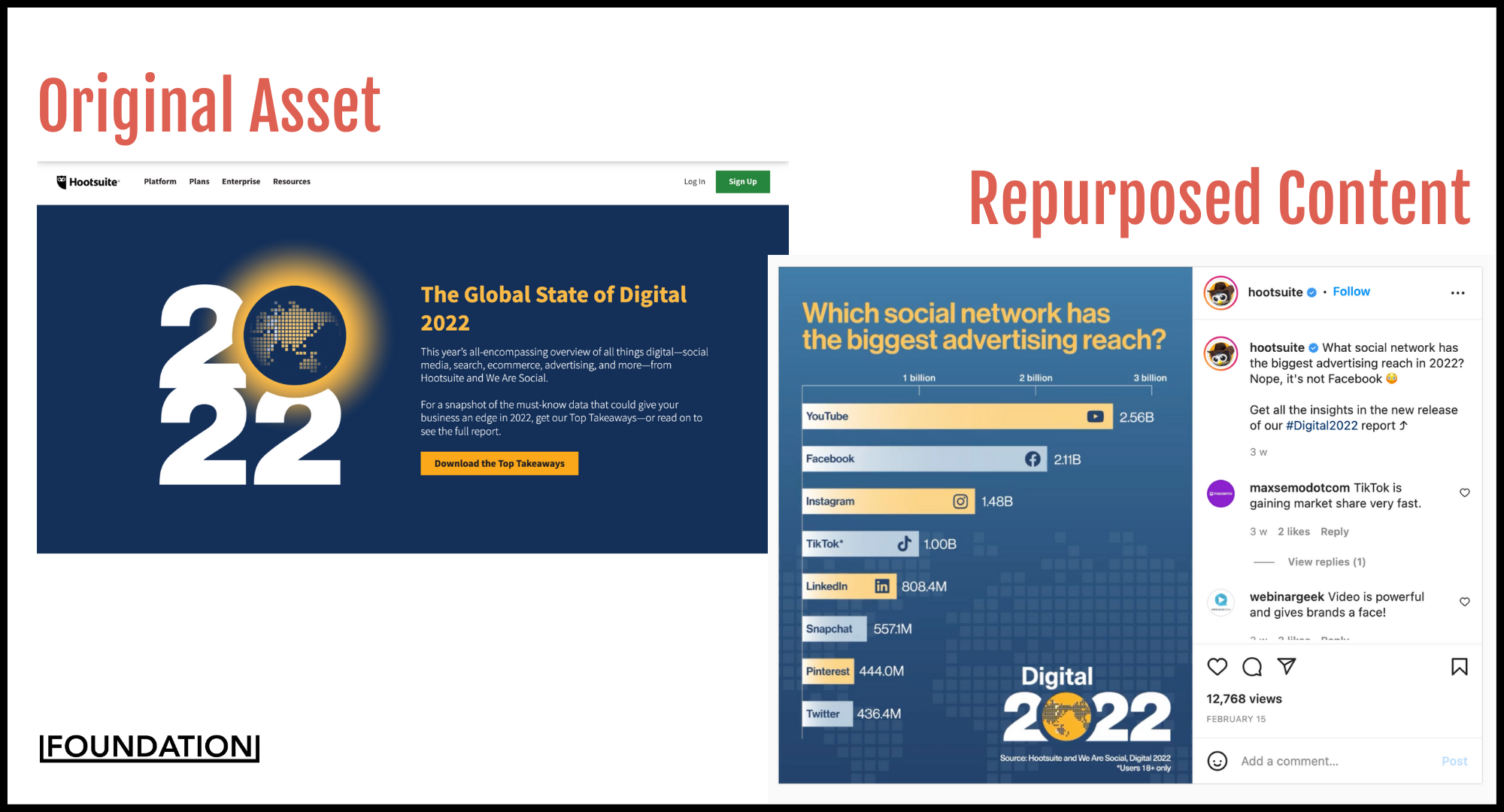
Advertisers on social media will be drawn to a graphic like this as it offers useful info. Hootsuite also does the same for LinkedIn, amplifying a more relatable messaging and format for the platform:
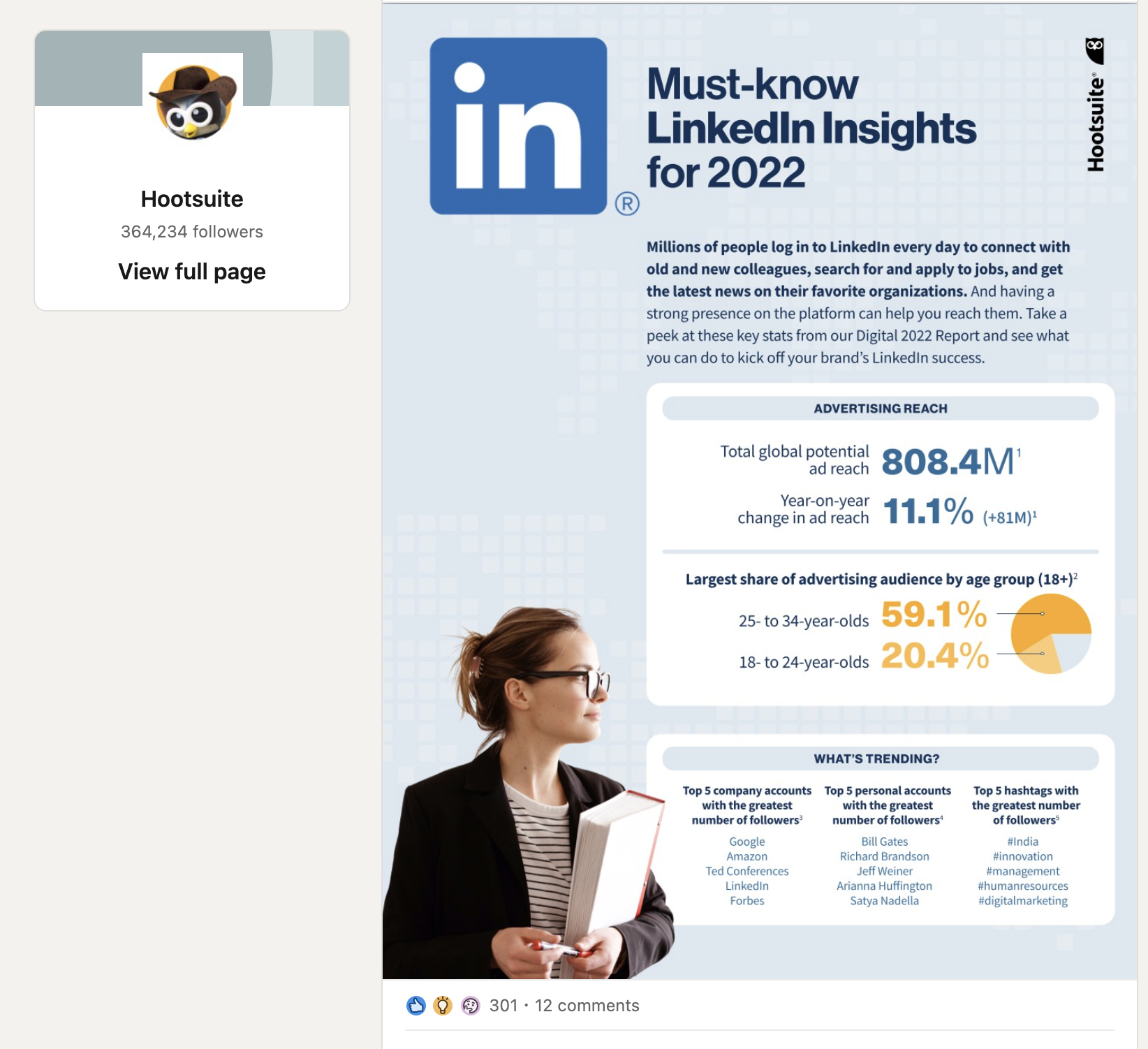
In this case, they chose an excerpt that LinkedIn users would find most beneficial, and it generated over 300 reactions and comments.
Whether or not you have a large marketing budget, you should repurpose existing or new content pieces into formats that suit your primary distribution channels. Distribute those pieces consistently, and you’ll see more traction, engagement, and potential conversions.
“If you do not subscribe to Foundation’s newsletter, you are missing out on a content marketing GOLDMINE. Definite must-read.”
– Rachael Hensley, Director of PR and Comms at Shippo
4. We Can’t Reshare the Same Content
Many brands fear reposting past social media content because they feel their audience may start to view their content as stale and repetitive. But they forget one thing: not everyone was online when you shared that insight on social media.
Updating and resharing older content over and over again is important because most of your audience may have missed the last share, and new people who joined your network haven’t seen the content yet. So assuming your audience will hate you for reposting is a sure way to overwhelm your team with unnecessary creation efforts.
Ross Simmonds puts it this way:
It’s a mistake to assume that everyone that would want to read your content just happened to be online at the same time as you posted it. Reshare. Repost. Create once. Distribute forever. Don’t let content collect dust.
Take it from the Distribution King himself. Make redistributing older content a part of your strategy. The best practice is to reshare as often as necessary. Perhaps, give a 6-8 week interval before resharing the same copy or graphic again.
Alternatively, you can remix the content—say it in a different way and redistribute it even earlier. You could shorten a long text post, pair it with a meme, or turn the entire piece into a graphic or video. Repetition helps with memory retention, especially when things are restated in different memorable ways. So have fun with it.
5. People Don’t Like It When We Promote Our Stuff
Another reason brands are hesitant to amplify their product’s value on social media is because they think they’re going to overdo it.
In reality, no one cares how often you share your content. People care more about whether or not your content solves their problem. So you shouldn’t worry about upsetting people when you distribute your content.
Senior Content Strategy Lead and Distribution Expert Nicole Jackson recently shared this on LinkedIn:
You’re not going to annoy anybody through distribution. First, because nobody is watching you as closely as you think they are. Second, because those who are interested will stay interested, and those who aren’t weren’t the right fit to begin with (so your content marketing has done its job).
I’m pretty sure you had tons of ClickUp ads pop up while watching a YouTube video or scrolling through social media. Perhaps you found it annoying, or maybe you didn’t 😉. That did not stop ClickUp from getting impressive results from their efforts:
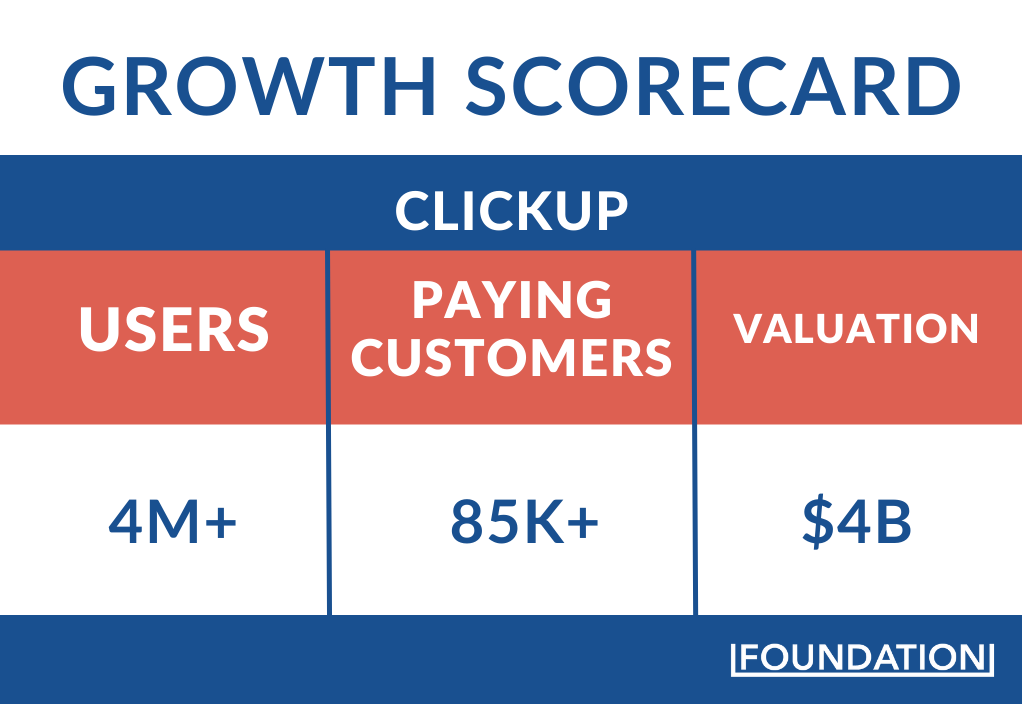
The team leveraged the power of organic and paid distribution to drive massive success for ClickUp. Sure, some people may have found them annoying at the time, but 85,000 paying customers found them relevant enough to exchange money for their value.
So much for “people don’t like it when we promote our stuff.” Like we say in Nigeria, “This misconception is now in the mud.” This means it’s been debunked. If you need proof, look at ClickUp.
People care more about content that solves their problems than how often you share your content. So distribute relevant native content on each channel. Share on X
6. We Can’t Scale Content Distribution
Creating a scalable distribution strategy is no easy feat, but it is not impossible. You need a strategic plan.
We had an e-commerce agency client who struggled to scale their organic and word-of-mouth leads before we partnered with them. They were actively but inconsistently using social media to reach their target audience and drive traffic to their website. However, they struggled because they didn’t have a strategic plan.
After auditing the company’s existing distribution strategy, we conducted a holistic competitor and industry analysis to understand the behavior of its qualified target audience, its competitors, and the overall trends within the e-commerce space. Then we used these insights to create a 12-month distribution strategy.
By maintaining a consistent content creation and distribution schedule, we saw 143% sales growth. Here’s a breakdown of the results:
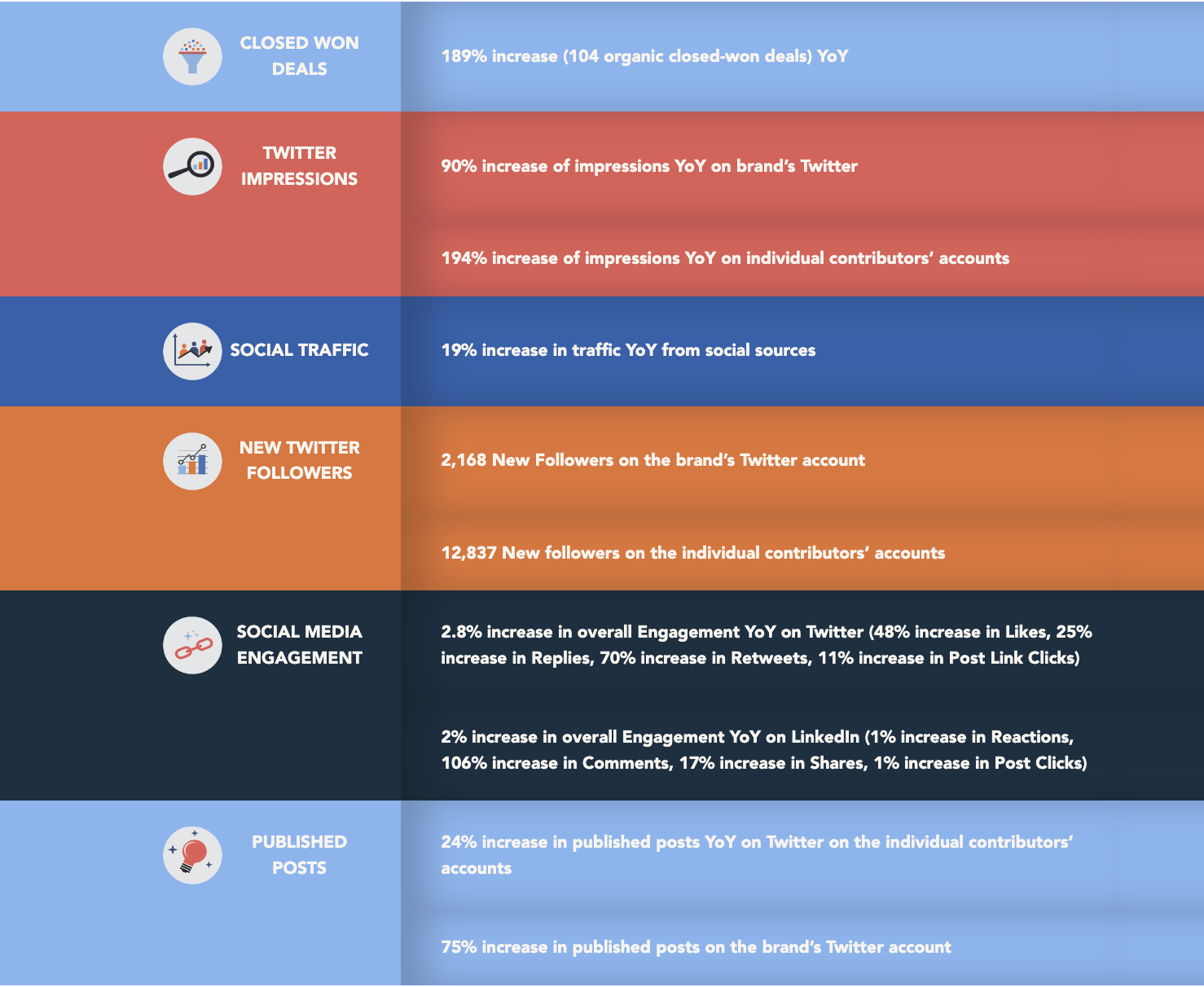
These results prove that you can scale with the right distribution strategy. You don’t need more content, backlinks, infographics, tools, and talents to scale your content marketing efforts. All you need is a solid distribution plan beyond link dumps on social media. Like John Bonini, Director of Marketing at Databox, wrote:
Just like content creation, content distribution is about finding your angle and differentiating from everything else out there. Link dumping achieves neither.
Here is a distribution playbook you can use as inspiration to create yours:
Day One: Amplification On Social
- Share on X w. Headline
- Share on X as a Thread
- Share on LinkedIn w. Long Form
- Post Share on Facebook page w. 3-4 sentences
Day Two: Amplify Through Native Channels
- Upload & Publish As A Medium Article
- Upload & Publish As A LinkedIn Article
- Repost The Original Thread From Yesterday
Day Three: Community Driven Distribution
- Amplify In A Slack Community
- Amplify In A Facebook Group
- Amplify In A Discord Channel
- Submit To An Industry Forum (x2)
Day Four: Newsletters & Mixing Things Up
- Reshare Link On X
- Share A Link On Your IG Story
- Reach Out To Friendlies For Engagement
- Promote Internally For Employee Advocacy
- Write Scripts For SDRs/BDRs to Use For Prospects/Leads
- Add To Your Email Signature For The Week
Day Five: Influencer Outreach Efforts
- Reach Out To Industry Newsletters
- DM Industry Influencers w. Link
- Pin Post To Article At The Top Of Your Channels
- Respond To Influencers Posts (Add Value) then link to your asset
- Engage A TikToker To Create Content About The Asset
Day Six: Repurposing Time
- Turn The Blog Post Into A YouTube Video
- Turn The Blog Post Into A Instagram Carousel
- Turn The Blog Post Into A LinkedIn Document
- Turn The Blog Post Into A Slideshare Deck
- Turn The Blog Post Into A Vertical Video
Wrap Up: Take Up The Distribution Challenge
There you have it: six content distribution misconceptions debunked with some examples and solid proof. In case you skimmed through, here are some key takeaways:
- Invest 75% of your resources into repurposing blog content into native content for your primary social channel(s) and distributing consistently.
- Leverage social selling like Dreamdata if you have a small budget
- Instead of replicating the same content format across platforms, you should repurpose your content into different formats to fit each channel.
- Make redistributing older content a part of your strategy.
- Promote relevant content shamelessly.
- You can scale with distribution. All you need is a solid distribution plan that goes beyond link dumps on social media.
You, too, can unlock the full potential of the content you create by embracing distribution. You can get started by joining the distribution challenge—a 2-week training program breaking down the exact processes and strategies we use to drive growth for ourselves and our clients.







